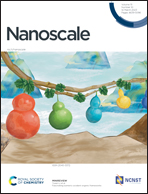Self-propelled continuous transport of nanoparticles on a wedge-shaped groove track†
Abstract
Controlling the directional motion of nanoparticles on the surface is particularly important for human life, but achieving continuous transport is a time-consuming and demanding task. Here, a spontaneous movement of nanoflakes on a wedge-shaped groove track is demonstrated by using all-atom molecular dynamics (MD) simulations. Moreover, an optimized track, where one end of the substrate is cut into an angle, is introduced to induce a sustained directional movement. It is shown that the wedge-shaped interface results in a driving force for the nanoflakes to move from the diverging to the converging end, and the angular substrate provides an auxiliary driving force at the junction to maintain continuous transport. A force analysis is carried out in detail to reveal the driving mechanism. Moreover, the sustained transport is sensitive to the surface energy and structural characteristics of the track: the nanoflakes are more likely to move continuously on the track with lower surface energy and a smaller substrate and groove opening angle. The present findings are useful for designing nanodevices to control the movement of nanoparticles.



 Please wait while we load your content...
Please wait while we load your content...